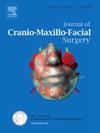Early management of anterior disc displacement without reduction: Evaluating the effectiveness of modified arthroscopy discopexy with anterior disc repositioning splint
IF 2.1
2区 医学
Q2 DENTISTRY, ORAL SURGERY & MEDICINE
引用次数: 0
Abstract
Background
This study aims to assess the therapeutic efficacy of a modified arthroscopy discopexy suturing technique in combination with an anterior disc repositioning splint (ARS) for the treatment of early phase anterior disc displacement without reduction (ADDwoR) patients.
Methods
During 2021–2022, early phase ADDwoR cases were included and underwent modified arthroscopy discopexy suturing surgery and ARS therapy after surgery. Pre- and post-surgical evaluation parameters include the visual analogue scale (VAS) for pain, maximum mouth opening (MMO), and disc-condyle relationship on MRI. Patients were followed up for a period of 6 months after surgery. Statistical significance was considered when p < 0.05.
Results
A total of 31 unilateral early phase ADDwoR cases were included, with an average age of 26.97. The VAS scores of pain decreased from 4.87 to 1.61, while MMO increased from 23.13 mm to 39.35 mm(p < 0.05). MRI evaluations at 1 month and 6 months post-surgical revealed a disc reduction rate of 93.55% and 90.32%, respectively.
Conclusion
The modified arthroscopy discopexy suturing technique combined with ARS therapy after surgery proves to be an effective, minimally invasive and simplified approach for the treatment of early phase ADDwoR patients.
椎间盘前部移位的早期处理,不需复位:评估改良关节镜椎间盘切除术与前椎间盘复位夹板的有效性。
研究背景本研究旨在评估改良关节镜下椎间盘切除缝合术与椎间盘前路复位夹板(ARS)相结合治疗早期椎间盘前移不缩小症(ADDwoR)患者的疗效:方法:2021-2022年间,纳入早期ADDwoR病例,接受改良关节镜椎间盘切除缝合手术,术后接受ARS治疗。手术前后的评估参数包括疼痛的视觉模拟量表(VAS)、最大张口度(MMO)和核磁共振成像上的椎间盘与椎髁关系。术后对患者进行了为期 6 个月的随访。统计意义以 p 为准:共纳入 31 例单侧 ADDwoR 早期病例,平均年龄为 26.97 岁。疼痛的 VAS 评分从 4.87 分降至 1.61 分,而 MMO 则从 23.13 mm 增至 39.35 mm(p 结论:ADDwoR 患者的疼痛评分从 4.87 分降至 1.61 分,而 MMO 则从 23.13 mm 增至 39.35 mm:改良关节镜椎间盘切除缝合技术结合术后 ARS 治疗被证明是治疗早期 ADDwoR 患者的一种有效、微创和简化的方法。
本文章由计算机程序翻译,如有差异,请以英文原文为准。
求助全文
约1分钟内获得全文
求助全文
来源期刊
CiteScore
5.20
自引率
22.60%
发文量
117
审稿时长
70 days
期刊介绍:
The Journal of Cranio-Maxillofacial Surgery publishes articles covering all aspects of surgery of the head, face and jaw. Specific topics covered recently have included:
• Distraction osteogenesis
• Synthetic bone substitutes
• Fibroblast growth factors
• Fetal wound healing
• Skull base surgery
• Computer-assisted surgery
• Vascularized bone grafts

 求助内容:
求助内容: 应助结果提醒方式:
应助结果提醒方式:


